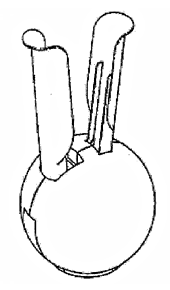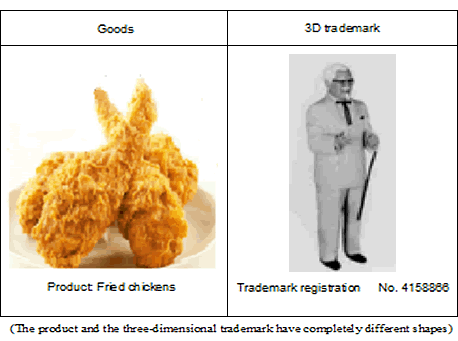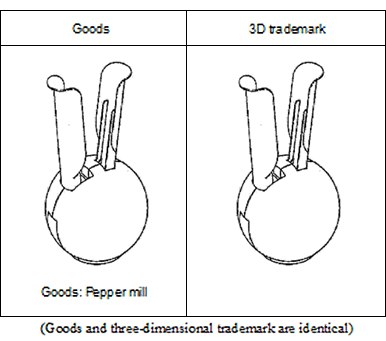vol. 1 “We Gotta Get a 3D Trademark!”
A 3-D trademark of a “pepper mill” represented by our office was successfully registered.

This case has been highly publicized as it was the first case in which distinctiveness was recognized from the shape inherent to the goods. In fact, the applicant approached our office for help after another patent office refused to handle the case.
What makes this case so unique? Why this case was unprecedented? Why has this case attracted so much attention? First, let me explain the background of the case.
- Conventional Concept of Trademarks
Conventionally, a trademark refers to a two-dimensional design or brand-name such as Sony, Gucci or Corolla attached to or printed on goods. This helped consumers differentiate goods because they could see those names and logos and know who the manufacturer was when purchasing products. As such, trademarks have traditionally meant two-dimensional marks to be “affixed” to goods. - Use of Three-Dimensional Trademarks
Then along came an idea: instead of a mark affixed to goods, trademarks could also be a promotional figure, the container, the shape of the goods themselves, or even just the shape of one part of the product. Say, for example, when someone sees a certain three-dimensional object, he or she would read and pronounce certain letters as if those letters were written in a two-dimensional way. For example, when you see a figure of Colonel Sanders standing in front of a store, the name Kentucky Fried Chicken would come into your mind along with a mental image of their fried chicken.
Instead of a signboard, in case of goods themselves, Coca Cola’s distinctive typeface would pop into your mind when you see the curved bottle, Hiyoko’s letters would pop into your head when you see a bun in the shape of a baby chick, and the letters of Parker would pop into your mind when you see the arrow-shaped clip of a fountain pen. Consequently, in the United States and in many countries in Europe, a system to recognize “three-dimensional trademarks” was established two decades ago. - The Situation in Japan
Against this international background, Japan started a system allowing the registration of three-dimensional shapes having “distinctiveness,” that is, the system of “three-dimensional trademarks.” Consequently, the Peko-chan figure of Fujiya, the Sanders doll of Kentucky Fried Chicken and the Coca Cola bottle? were registered as trademarks. They were registrable because (1) the shapes of the goods and the three-dimensional trademark are completely different, or (2) they are well-recognized ?due to repeated use over the years.

- No Distinctiveness
As such, in Japan, even though the system of three-dimensional trademark exists, there are few cases of registered three-dimensional marks, unless they are extremely well recognized. ?Most applications are rejected for the reason that “the shape merely represents the shape of the goods in a commonly-used manner.” Suppose an application is filed for a whisky bottle marked with notches, indents and various lines to be registered as a three-dimensional trademark. This application would be rejected based on the premise that: “those notches and intents are merely used to help hold the bottle or to enhance the aesthetic quality” and that “there is no distinctiveness.”

Even the famous square bottle of Suntory’s whiskey fell to this logic. When Suntory filed an application for registration arguing that “the shape should be treated as an exception and should be registered because it is a well-recognized shape due to repeated use over the years,” the application was rejected on the ground that “it became famous because the bottle bears the letters of ‘Suntory,’ thus there is no distinctiveness in the shape of the container itself.”
- The Case of the “Pepper Mill”
Under these circumstances, the three-dimensional trademark of the “pepper mill” handled by our office was registered without the standard exception of being well recognized, but rather for the shape of the pepper container. ?(Here again, let me repeat that, before this case, all registered three-dimensional trademarks and their associated goods had completely different forms, such as the “Colonel Sanders Figure” being the trademark for the fried chicken it represented.)
Regarding this case, other patent offices had given up refutation because there is no possibility of winning. However, the applicant was not willing to give up and came to us for help.

- Our Refutation
We made an appeal to the patent court, and at that stage the examiner initially pointed out that “the shape merely represents the shape of the goods in a commonly-used manner.” ?However, we argued that, “if you say this is a common shape, let us ask you a question. Mr. Examiner, can you tell where exactly pepper corns are placed into the container?” We also built our case with various arguments including the “Foreign Registered Trademark” law under the Paris Convention. ?As a result, the examiner concluded: “I see. Indeed, by just looking at the shape of the rabbit’s head, it is unimaginable that this is used for grinding peppers.” Consequently, the trademark was registered. In other words, the examiner concluded that it had a distinctive character not expected from the use, purpose and function of a pepper mill. Therefore, it was beyond the scope of the commonly-used shape of a pepper mill. This is why this case has been recognized as the first case of a trademark being the actual product itself, without being subjected to exceptional treatment as being well-recognized. We look forward to finding out how this decision influences the examination of three-dimensional trademarks in the future.

